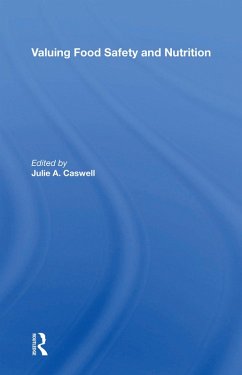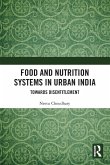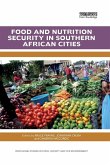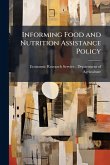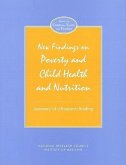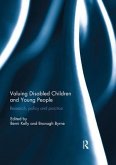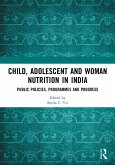Julie A Caswell
Valuing Food Safety And Nutrition
Schade – dieser Artikel ist leider ausverkauft. Sobald wir wissen, ob und wann der Artikel wieder verfügbar ist, informieren wir Sie an dieser Stelle.
Julie A Caswell
Valuing Food Safety And Nutrition
- Broschiertes Buch
- Merkliste
- Auf die Merkliste
- Bewerten Bewerten
- Teilen
- Produkt teilen
- Produkterinnerung
- Produkterinnerung
This book focuses on the developing field of valuing food safety and nutrition. It evaluates the relative strengths, weaknesses, and requirements of the major methodologies employed in valuation research. The book includes a discussion on key factors such as information on consumer attitudes.
Andere Kunden interessierten sich auch für
![Food and Nutrition Systems in Urban India Food and Nutrition Systems in Urban India]() Neetu ChoudharyFood and Nutrition Systems in Urban India57,99 €
Neetu ChoudharyFood and Nutrition Systems in Urban India57,99 €![Food and Nutrition Security in Southern African Cities Food and Nutrition Security in Southern African Cities]() Food and Nutrition Security in Southern African Cities59,99 €
Food and Nutrition Security in Southern African Cities59,99 €![Informing Food and Nutrition Assistance Policy Informing Food and Nutrition Assistance Policy]() Informing Food and Nutrition Assistance Policy15,99 €
Informing Food and Nutrition Assistance Policy15,99 €![New Findings on Poverty and Child Health and Nutrition New Findings on Poverty and Child Health and Nutrition]() National Research Council and Institute of MedicineNew Findings on Poverty and Child Health and Nutrition28,99 €
National Research Council and Institute of MedicineNew Findings on Poverty and Child Health and Nutrition28,99 €![Valuing Disabled Children and Young People Valuing Disabled Children and Young People]() Valuing Disabled Children and Young People59,99 €
Valuing Disabled Children and Young People59,99 €![Child, Adolescent and Woman Nutrition in India Child, Adolescent and Woman Nutrition in India]() Child, Adolescent and Woman Nutrition in India52,99 €
Child, Adolescent and Woman Nutrition in India52,99 €![Valuing Care Work Valuing Care Work]() Valuing Care Work43,99 €
Valuing Care Work43,99 €-
-
-
This book focuses on the developing field of valuing food safety and nutrition. It evaluates the relative strengths, weaknesses, and requirements of the major methodologies employed in valuation research. The book includes a discussion on key factors such as information on consumer attitudes.
Produktdetails
- Produktdetails
- Verlag: Taylor & Francis Ltd
- Seitenzahl: 458
- Erscheinungstermin: 30. September 2020
- Englisch
- Abmessung: 229mm x 146mm
- Gewicht: 890g
- ISBN-13: 9780367215767
- ISBN-10: 0367215764
- Artikelnr.: 75653807
- Herstellerkennzeichnung
- Libri GmbH
- Europaallee 1
- 36244 Bad Hersfeld
- gpsr@libri.de
- Verlag: Taylor & Francis Ltd
- Seitenzahl: 458
- Erscheinungstermin: 30. September 2020
- Englisch
- Abmessung: 229mm x 146mm
- Gewicht: 890g
- ISBN-13: 9780367215767
- ISBN-10: 0367215764
- Artikelnr.: 75653807
- Herstellerkennzeichnung
- Libri GmbH
- Europaallee 1
- 36244 Bad Hersfeld
- gpsr@libri.de
Julie A. Caswell
Part One: Setting the Stage: Research Perspectives and Theoretical Models
1. Valuing Food Safety and Nutrition: The Research Needs 2.
Self-Protection, Risk Information, and Ex Ante Values of Food Safety and
Nutrition 3. Mitigation, Product Substitution, and Consumer Valuation of
Undesirable Foodborne Effects 4. Information Issues for Principals and
Agents in the "Market" for Food Safety and Nutrition Part Two: A Comparison
of Valuation Methodologies 5. Contingent Valuation of Health Risk
Reductions for Shellfish Products 6. Experimental Auctions to Measure
Willingness to Pay for Food Safety 7. Using Conjoint Analysis to Assess
Consumers' Acceptance of pST-Supplemented Pork 8. Health Risk Concern of
Households vs. Food Processors: Estimation of Hedonic Prices in Fats and
Oils 9. Valuation by the Cost of Illness Method: The Social Costs of
Escherichia coli 0157:H7 Foodborne Disease 10. Valuing Food Safety: Which
Approaches to Use? 11. Thoughts About Different Methods to Value Food
Safety and Nutrition Part Three: A Closer Look at Performing Contingent
Valuation 12. Using Contingent Valuation to Value Food Safety: A Case Study
of Grapefruit and Pesticide Residues 13. Anglers' Willingness to Pay for
Information About Chemical Residues in Sport Fish: Design of a CV
Questionnaire 14. Using Contingent Valuation Methods to Value the Health
Risks from Pesticide Residues When Risks Are Ambiguous 15. Contingent
Valuation of Consumers' Willingness to Purchase Pork with Lower Saturated
Fat 16. Criteria for Evaluating Results Obtained from Contingent Valuation
Methods Part Four: Inputs to Valuation Studies 17. Determining Foodborne
Illness in the United States: A Step Toward Valuation 18. Measuring the
Food Safety Risk of Pesticides 19. Adding Nutritional Quality to Analysis
of Meat Demand 20. Irradiation and Food Safety: Consumer Attitudes and
Awareness
1. Valuing Food Safety and Nutrition: The Research Needs 2.
Self-Protection, Risk Information, and Ex Ante Values of Food Safety and
Nutrition 3. Mitigation, Product Substitution, and Consumer Valuation of
Undesirable Foodborne Effects 4. Information Issues for Principals and
Agents in the "Market" for Food Safety and Nutrition Part Two: A Comparison
of Valuation Methodologies 5. Contingent Valuation of Health Risk
Reductions for Shellfish Products 6. Experimental Auctions to Measure
Willingness to Pay for Food Safety 7. Using Conjoint Analysis to Assess
Consumers' Acceptance of pST-Supplemented Pork 8. Health Risk Concern of
Households vs. Food Processors: Estimation of Hedonic Prices in Fats and
Oils 9. Valuation by the Cost of Illness Method: The Social Costs of
Escherichia coli 0157:H7 Foodborne Disease 10. Valuing Food Safety: Which
Approaches to Use? 11. Thoughts About Different Methods to Value Food
Safety and Nutrition Part Three: A Closer Look at Performing Contingent
Valuation 12. Using Contingent Valuation to Value Food Safety: A Case Study
of Grapefruit and Pesticide Residues 13. Anglers' Willingness to Pay for
Information About Chemical Residues in Sport Fish: Design of a CV
Questionnaire 14. Using Contingent Valuation Methods to Value the Health
Risks from Pesticide Residues When Risks Are Ambiguous 15. Contingent
Valuation of Consumers' Willingness to Purchase Pork with Lower Saturated
Fat 16. Criteria for Evaluating Results Obtained from Contingent Valuation
Methods Part Four: Inputs to Valuation Studies 17. Determining Foodborne
Illness in the United States: A Step Toward Valuation 18. Measuring the
Food Safety Risk of Pesticides 19. Adding Nutritional Quality to Analysis
of Meat Demand 20. Irradiation and Food Safety: Consumer Attitudes and
Awareness
Part One: Setting the Stage: Research Perspectives and Theoretical Models
1. Valuing Food Safety and Nutrition: The Research Needs 2.
Self-Protection, Risk Information, and Ex Ante Values of Food Safety and
Nutrition 3. Mitigation, Product Substitution, and Consumer Valuation of
Undesirable Foodborne Effects 4. Information Issues for Principals and
Agents in the "Market" for Food Safety and Nutrition Part Two: A Comparison
of Valuation Methodologies 5. Contingent Valuation of Health Risk
Reductions for Shellfish Products 6. Experimental Auctions to Measure
Willingness to Pay for Food Safety 7. Using Conjoint Analysis to Assess
Consumers' Acceptance of pST-Supplemented Pork 8. Health Risk Concern of
Households vs. Food Processors: Estimation of Hedonic Prices in Fats and
Oils 9. Valuation by the Cost of Illness Method: The Social Costs of
Escherichia coli 0157:H7 Foodborne Disease 10. Valuing Food Safety: Which
Approaches to Use? 11. Thoughts About Different Methods to Value Food
Safety and Nutrition Part Three: A Closer Look at Performing Contingent
Valuation 12. Using Contingent Valuation to Value Food Safety: A Case Study
of Grapefruit and Pesticide Residues 13. Anglers' Willingness to Pay for
Information About Chemical Residues in Sport Fish: Design of a CV
Questionnaire 14. Using Contingent Valuation Methods to Value the Health
Risks from Pesticide Residues When Risks Are Ambiguous 15. Contingent
Valuation of Consumers' Willingness to Purchase Pork with Lower Saturated
Fat 16. Criteria for Evaluating Results Obtained from Contingent Valuation
Methods Part Four: Inputs to Valuation Studies 17. Determining Foodborne
Illness in the United States: A Step Toward Valuation 18. Measuring the
Food Safety Risk of Pesticides 19. Adding Nutritional Quality to Analysis
of Meat Demand 20. Irradiation and Food Safety: Consumer Attitudes and
Awareness
1. Valuing Food Safety and Nutrition: The Research Needs 2.
Self-Protection, Risk Information, and Ex Ante Values of Food Safety and
Nutrition 3. Mitigation, Product Substitution, and Consumer Valuation of
Undesirable Foodborne Effects 4. Information Issues for Principals and
Agents in the "Market" for Food Safety and Nutrition Part Two: A Comparison
of Valuation Methodologies 5. Contingent Valuation of Health Risk
Reductions for Shellfish Products 6. Experimental Auctions to Measure
Willingness to Pay for Food Safety 7. Using Conjoint Analysis to Assess
Consumers' Acceptance of pST-Supplemented Pork 8. Health Risk Concern of
Households vs. Food Processors: Estimation of Hedonic Prices in Fats and
Oils 9. Valuation by the Cost of Illness Method: The Social Costs of
Escherichia coli 0157:H7 Foodborne Disease 10. Valuing Food Safety: Which
Approaches to Use? 11. Thoughts About Different Methods to Value Food
Safety and Nutrition Part Three: A Closer Look at Performing Contingent
Valuation 12. Using Contingent Valuation to Value Food Safety: A Case Study
of Grapefruit and Pesticide Residues 13. Anglers' Willingness to Pay for
Information About Chemical Residues in Sport Fish: Design of a CV
Questionnaire 14. Using Contingent Valuation Methods to Value the Health
Risks from Pesticide Residues When Risks Are Ambiguous 15. Contingent
Valuation of Consumers' Willingness to Purchase Pork with Lower Saturated
Fat 16. Criteria for Evaluating Results Obtained from Contingent Valuation
Methods Part Four: Inputs to Valuation Studies 17. Determining Foodborne
Illness in the United States: A Step Toward Valuation 18. Measuring the
Food Safety Risk of Pesticides 19. Adding Nutritional Quality to Analysis
of Meat Demand 20. Irradiation and Food Safety: Consumer Attitudes and
Awareness

